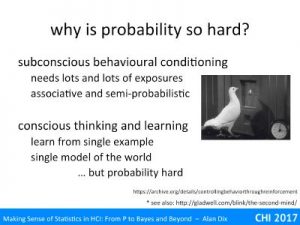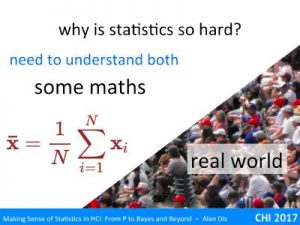 Do you find probability and statistics hard? If so, don’t worry, it’s not just you; it’s basic human psychology.
Do you find probability and statistics hard? If so, don’t worry, it’s not just you; it’s basic human psychology.
We have two systems of thought (i) subconscious reactions that are based on semi-probabilistic associations, and (ii) conscious thinking that likes to have one model of the world and is really bad at probability. This is why we need to use mathematics and other explicit techniques to help us deal with probabilities.
Statistics both needs this mathematics of probability and an understanding of what it means in the real world. Understanding this means you don’t have to feel bad about finding stats hard (!), but also helps to find ways to make it easier.
Skinner’s famous experiments with pigeons showed how certain kinds of learning could be studied in terms of associations between stimuli and rewards. If you present a reward enough times with the behaviour you want, the pigeon will learn to do it even when the original reward no longer happens.
This low-level learning is semi-probabilistic in the sense that if rewards are more common the learning is faster or if rewards and penalties both happen at different frequencies, then you get a level of trade-off in the learning. At a cognitive level one can think of strengths of association being built up with rewards strengthening them and penalties inhibiting them.
This kind of learning is not quite a weighted sum of past experience: for example negative experiences typically count more than positive ones, and once a pattern is established it takes a lot to shift it. However, it is not so far from a probability estimate.
We humans share this subconscious learning processes with other animals, and at some periods this has been used explicitly in education. It is powerful and leads to very rapid reactions, but needs very large numbers of exposures to similar situations to establish memories.
Of course we are not just our subconscious! In addition we have conscious thinking and reasoning. This is powerful in that, amongst other things, we are able to learn from a single experience. Retrospectively we are able to retrieve even a single relevant past experience, compare it to what we are encountering now, and work what to do based on it.
This is very powerful, but unlike our more unconscious sea of overlapping memories and associations, our conscious mind is linear and is normally locked into a single model of the world1.
Because of this single model of the world this form of thinking is not so good at intuitively grasping probabilities, as is repeatedly evidenced by gambling behaviour and more broadly our assessment of risk.
One experiment uses cards with different coloured backs, red and blue2. In the experiment the cards are initially dealt to the subject face down and then turned over. Some cards have a rewards, “you have won £5”, other a penalty, “sorry you’ve lost half your winnings”. The cards differ in that one colour, let’s say blue, has more penalties, and the other a better balance of rewards.
After playing a while the subjects realise that the packs are different and can tell you which s better.
However, the subjects are also wired up to a skin conductivity sensor as used in a lie detector. Well before they are able to say that one of the card colours is worse then the other they show a response on the sensor – that is subconsciously they know it is a bad card.
Although our conscious mind is not naturally good at dealing with probabilities , we are able to reason explicitly about them using mathematics. For example, if the subjects in the experiment had kept a tally of good and bad cards, they would have seen, in the numbers, that the red cards were better.
Some years ago, when I first was doing some statistical teaching I remember learning that statistics teaching was known to be particularly difficult. This is in part because it requires a combination of maths and real world thinking.
In statistics we use the explicit tallying of data and mathematical reasoning about probabilities to let is do quite complex reasoning from effects (measurements) back to causes (the real word phenomena that are being measured).
So you do need to feel reasonably comfortable with this mathematics.
However, even if you are a whizz at maths, if you can’t relate this back to understanding about the real world, you are also stuck. It is a bit like the applied maths problems where people get so lost in the maths that they forget the units: “the answer is 42” – but 42 what? 42 degrees centigrade, 42 metres, or 42 bananas?
On the whole those good at mathematics are not always good at relating their thinking back to the real world, and those of a more practical disposition not always best at maths – no wonder statistics is hard!
However, knowing this we can try to make things better.
In the “making sense of statistics” I am focusing more on those who have a reasonable sense of the practical issues and will try to explain some of the concepts that necessary without getting deep into the mathematics of how they are calculated … leave that to the computer!
- There are exceptions to the conscious mind’s single model of the world including when we tell each other stories or write; see my essay “writing as third order experience“. [↩]
- Malcolm Gladwell describes this experiment in ‘The Second Mind‘, an online excerpt of his book Blink [↩]


